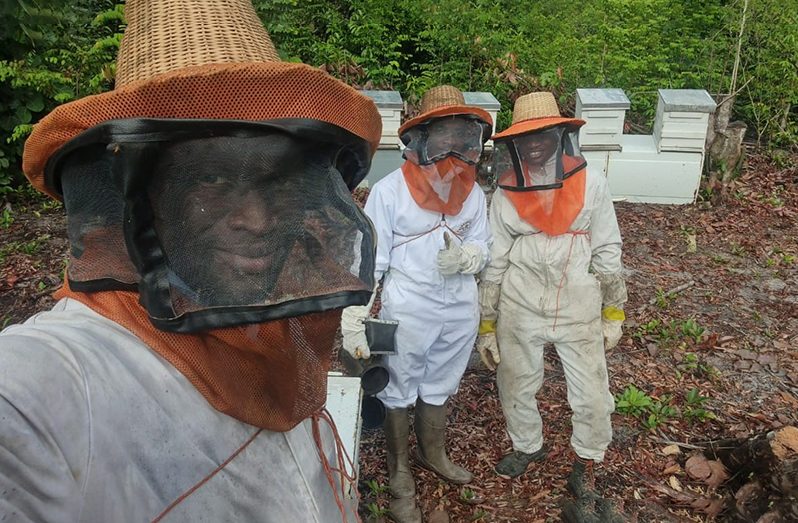THE buzz of bees is something we are all familiar with. But for Aubrey Roberts, the hum of bees has been the soundtrack of his life for over three decades. What began as a curious extracurricular activity at President’s College in 1989, quickly blossomed into a lifelong passion for the intricate, organised world of bees.
Now, with a thriving family-owned beekeeping business and years of experience under his belt, Aubrey stands as one of Guyana’s guardians of nature’s most vital creatures—pollinators that quietly sustain ecosystems and put food on our tables.
But as the climate shifts and the industry evolves, various challenges and questions present themselves: how do these tireless workers, and the people who care for them, adapt to a changing world? As we observe Agriculture Month, Aubrey sheds light on a few of these topics.
The hustle and bustle of bees
More than 35 years ago, a young and curious Aubrey came across the activity of beekeeping. What began as a simple pastime during his years at President’s College soon blossomed into a fascination with the meticulous organisation and brilliance of bees. Reflecting on his journey, Aubrey recalled, “I started beekeeping as a student of President’s College in 1989. Beekeeping was an extracurricular activity, and a number of us were exposed to beekeeping at a small apiary, where we learned to take care of bees.”
Aubrey was initially captivated by the productivity and orderliness of bees, describing them as “advanced social insects, in that they live in colonies, are managed by a queen, and work together to build a hive from scratch. Then they protect it, maintain it, store honey, and produce several premium products.” But for Aubrey, there’s more to bees and beekeeping than meets the eye.

Beekeepers in Guyana
Over the years, Aubrey has seen the industry grow, particularly in the number of beekeepers. Although still a small community of just a few hundred people, the group continues to expand, with pioneers like Aubrey leading the way. As he explained, “Some 20 years ago, we were the only people offering removal services. Now, there are several service providers.”
Many people may not know much about the apiculture industry in Guyana, but according to Aubrey, beekeeping is certainly a good way to make a living. His business, Kingdom Apiary, has several locations and many beehives around Guyana, with one of the most popular being in Long Creek, along the Soesdyke-Linden Highway.
His business offers more than honey, selling various apiary products and supplies, which he runs with his wife. The duo, along with their other partners, provide honey, hives, gear, and beekeeping equipment. “Most of the equipment is manufactured locally,” Aubrey added, sharing that the grills, smokers, and frames are produced in Guyana.
Bees and the climate
After more than three and a half decades, Aubrey has paid close attention and learned plenty about the symbiotic relationship between bees and nature. He explained, “Bees depend on the trees, and the trees depend on the bees.” This connection is vital for ecosystems, especially in agricultural settings. “Beekeeping is an important subsector of agriculture,” he remarked. “About 25% of all the food, the grasses, and the trees—even those that don’t bear fruit—require pollination for propagation.”
However, beekeeping faces challenges, particularly with climate change. “Climate change is affecting us in terms of the changes in weather patterns,” Aubrey shared. He explained that these massive shifts have a profound impact on bee production and, moreover, honey yield. This has made the profession unpredictable, with the usual timing of honey production disrupted and honey season changing from year to year.
Having problems with bees?
Aubrey isn’t just a beekeeper—he is also a bee remover, with people from all around Guyana reaching out to him. Throughout the years, he has seen more people venture into the field.
Despite the difficulties, Aubrey’s fascination with beekeeping has never waned. When asked about the largest hive he has encountered, he recalled, “I’ve seen a hive about four feet wide and four or five feet long, inside a wall.” He explained that bees are drawn to “cool, dark places,” like roofs or the spaces between walls, which is why they often settle in people’s homes.
For those who find bees in their homes or are attacked by bees, Aubrey shares some do’s and don’ts: “What you should not do is jump into water, because if you do that, bees will follow you.” Instead, he recommends securing yourself in a room with locked windows, preventing the bees from getting inside.
Looking at beehives, it’s easy to see what captivated a young Aubrey. With their intricate systems and the way they depend on each other, they are a great reminder of the codependency and co-operation needed in the world. The relationship between nature’s stakeholders, like bees and agriculture, is far more complex than most of us know. And although they are small, bees make a big difference.




.jpg)










